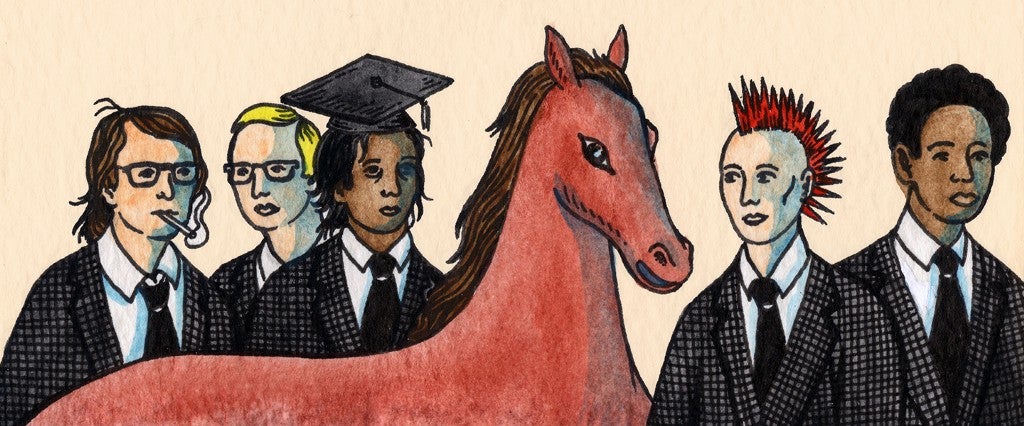Ethan Couch, the Texas teenager who killed four people and paralyzed another in 2013 while driving drunk, was originally sentenced to a stint at Newport Academy California, a $500,000-a-year rehab facility that Treatment Magazine called “the most beautiful treatment facility in the industry.” Newport’s amenities read like those at a luxury spa: Each resident is assigned a horse for equine-assisted psychotherapy; there’s an onsite gym, mixed martial arts, yoga and meditation; plus a certified organic chef who provides individual nutritional counseling.
It’s one of a growing number of “therapeutic boarding schools” in America, private, residential rehabilitation facilities for troubled adolescents and young adults of means. Or as Bloomberg Businessweek put it, “Affluenza Anonymous: Rehab for the Young, Rich, and Addicted.” Tuition varies depending on the school, but it generally starts at $100,000 a year. Most are single-sex; the rest are coed but separated within the campus by gender. There were only a handful of such schools in the 1990s, but they now number in the hundreds, according to the National Association of Therapeutic Schools and Programs.
How can boys become men in such soft environments?
Jessica Pfaffendorf, a PhD candidate in the School of Sociology at the University of Arizona, conducted nine months of fieldwork and 34 in-depth interviews with male teenagers at The Canyon Foundation, a therapeutic boarding school located in the Southwest. She was particularly interested in how feminized therapy models prominent in these programs — stressing powerlessness, relationship-building and open expression of emotions — conflicted with dominant notions of masculinity held by privileged teen boys. Her study, “Sensitive Cowboys — Privileged Young Men and the Mobilization of Hybrid Masculinities in a Therapeutic Boarding School,” is published in the current issue of Gender & Society.
She recently spoke with me about the increase in “affluenza academies” over the last 20 years, why equine and 12-step therapies are considered girly and how these young men of privilege employ “hybrid masculinities” to assert dominance over other men.

What exactly is a “therapeutic boarding school”?
They’re basically half rehab, half boarding school — rehabilitation facilities for troubled adolescents and young adults whose high school education has been interrupted. They often have college prep courses and offer a pretty good education. They also do intensive therapy every day depending on what issue the school treats.
What are the most common issues treated?
They vary widely. The school where I did my research treated substance abuse. But schools exist for all kinds of adolescent issues — depression, eating disorders, violence — and some deal with autism and other similar disorders. There are a lot of schools that treat multiple issues at once — bracketed under “troubled youth” — and treat depression alongside substance abuse alongside violence alongside anorexia.
Why have they grown in number over the years?
There was a big boom in the industry around the late 1990s. There have been a lot of high-profile cases of “troubled teens” in the media, starting with Columbine in 1999 and a slew of other school shooters where you see issues related to troubled youth and violence that may have created a moral panic in the national discourse. Alongside that, you have adolescent issues including autism, ADD and ADHD being recognized and treated explicitly as psychological and behavioral problems as well as an increased attention to mood disorders and depression. Therapy is becoming more routine and accepted, so more people are seeking it out.

Define “hybrid masculinities” as it applies here.
This refers to forms of masculinity that incorporate bits and pieces of femininity and subordinated masculinity that are incorporated strategically in ways that allow young men to reassert dominance and power in different ways.
How so?
A lot of the young men in my study fully embrace the therapeutic discourse of emotional expression, humility, commitment to service and sensitivity. But they would use those softer characteristics to assert dominance over other young men by talking about these qualities as a means of making them superior to the typical teen boy. Having gone through an experience like this, they considered themselves to be better communicators and more responsible, which helped them symbolically distance themselves from other young men. They turned something that most would view negatively as a stigma into a source of pride and a way of getting back some of their position.
In what?
A lot of my participants talked about how this helped them in dating because they suddenly were viewed by women as emotionally available guys who were able to talk about their feelings. They distanced themselves a lot from “frat bros” who were sexually promiscuous by talking about how much they respected women. They said this was a big draw for women their age. I met one of the girlfriends of the young men I was studying at the facility one day. She said, “I’ve never met anyone like him before. I’ve had two other real relationships with guys who you would call emotionally unavailable.” Her new boyfriend was the exact opposite.
What are common characteristics of these schools?
Rigorous structure and discipline. Every single minute of the day is planned at the school I observed. There wasn’t a second of unscheduled free time between 7:30 a.m. to 10 p.m. They’d have their first class after breakfast, like a high school, and interspersed between the classwork, they’d have different therapy sessions.
What kind of therapy?
One-on-one and group sessions. For substance-abuse treatment, they were introduced to the 12-step program and would work the steps with the staff and co-residents. There were wilderness excursions and animal-assisted therapy as well.
An equine therapist in your study said, “The experience allows one to move from the masculine postmodern world of logic, control and outcome production to the feminine stance of intuition, experience, and process.” Can you explain?
Equine therapy is based on something called “relationship-based riding,” which involves creating a trusting relationship with animals that are considered to be perceptive of human emotion and feelings. It’s designed to facilitate emotional growth in these boys, specifically outward expression of emotion and emotional consistency. It’s meant to cultivate things like empathy, compassion and caring about something outside of yourself. Those are typically characteristics and qualities that are associated with femininity. So it’s stripping away masculine qualities, giving up control, trusting and building a relationship and gaining emotional intuition.
Why isn’t the 12-step program capable of being manly?
Inherent to that 12-step model is admitting powerlessness over an addiction and accepting weakness. There’s a whole process of taking a moral inventory and recognizing all the ways you’ve wronged people in the past and making amends for them. It puts people in a vulnerable, submissive position. People who write about gender in support groups talk about the 12-step model as being much more consistent with how well-being is typically discussed among women than it is among men.
And yet, they still find a way to work this to their advantage?
Yep. Again, instead of resisting, they embrace therapies that invoke a feminized therapeutic discourse and use them to their advantage to achieve better outcomes with women and symbolically assert their dominance over other men.

